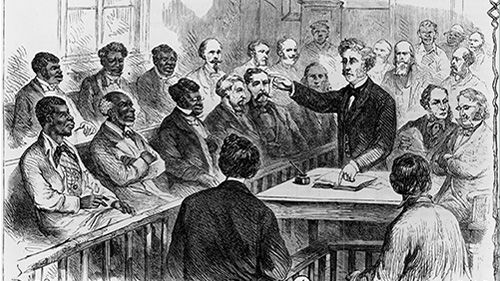The Most Foundational Document: The U.S. Constitution
As you know in our study of the AP ® U.S. Government, there are nine Foundational Documents. But one of these towers among the rest: the U.S....
AP & Honors Mathematics
Explore Wiley titles to support both AP and Honors mathematics instruction.
Literacy Skills & Intensive Reading
Connections: Reading – Grades 6–12
Empower student success with a proven intensive reading program that develops strong reading skills in striving readers.
Drama, Speech & Debate
Basic Drama Projects 10th Edition
Build students’ confidence and competence with comprehensive, project-based theatre instruction.
Literature
Connections: Literature
Support learners as they study dynamic, relevant texts and bring the richness of diverse voices to students through literature.
Literature & Thought
Develop critical thinking, reading, and writing across literacy themes, genres, historical eras, and current events.
Language Arts
Vocabu-Lit® – Grades 6–12
Help students build word power using high-quality contemporary and classic literature, nonfiction, essays, and more.
Connections: Writing & Language
Help students develop grammar, usage, mechanics, vocabulary, spelling, and writing and editing skills.
Reading/English Language Arts
Measuring Up to the English Language Arts Standards
Incorporate standards-driven teaching strategies to complement your ELA curriculum.
English Language Learners
Measuring Up for English Language Learners
Incorporate research-based best practices for ELLs with an approach that includes a focus on language acquisition strategies.
Mathematics
Measuring Up to the Mathematics Standards
Incorporate standards-driven teaching strategies to complement your mathematics curriculum.
Foundations
Measuring Up Foundations
Help students master foundational math skills that are critical for students to find academic success.
Science
Measuring Up to the Next Generation Science Standards
Give students comprehensive NGSS coverage while targeting instruction and providing rigorous standards practice.
Assessment
Measuring Up Live
Deliver innovative assessment and practice technology designed to offer data-driven instructional support.
For a better website experience, please confirm you are in:
Whether you were relieved or intimidated to see nine foundational documents in the AP® U.S. Government and Politics course after the redesign, you most likely had to alter your approach to document analysis in your class. While the direction as to which documents to teach is helpful, it can be overwhelming to decide how and to what depth to teach them. This post will discuss some of my favorite document analysis strategies, how the AMSCO® coursebook helped me prepare my students for success with the foundational documents, and a Declaration of Independence lesson plan.
When it comes to analyzing the foundational documents, my best advice is to start early. While Unit 1 only makes up 15–22% of the AP® exam, it has six of the nine foundational documents. Because it is so document heavy, Unit 1 will probably take up more than 15–22% of your instructional time. This feature of the course can also make it a little overwhelming to students at first, and, especially with the outdated language of many of the Unit 1 documents, can be discouraging. My AP® Government students are sophomores and, for many of them, mine is their first AP® class. That is intimidating enough and to add documents like Brutus I on top of that is a recipe for a trip to the guidance counselor for a schedule change. Even if AP® Government isn’t a student’s first AP® course, the last thing we want to do is have our students start out feeling overwhelmed. We need to spend time supporting those document analysis skills to set them up for success both in class and on the AP® exam. Time spent in the first unit building document analysis skills will pay dividends throughout the year as students will become more confident in their analytical skills and will eventually need fewer supports.
There are so many great strategies to support document analysis that are easy to incorporate into your class. Document analysis strategies also directly correlate with disciplinary practice 4 from the course and exam description which is to “Read, analyze, and interpret foundational documents and other text-based and visual sources.” Some of my favorite strategies are close reading, jigsaw, and fishbowl.
Close reading is a foundational strategy in document analysis. This strategy asks students to read and reread a document while annotating for key ideas and phrases, vocabulary terms, themes, or whatever else you want students to get out of the text. This strategy can be modified to fit each teacher or student’s preferred annotation style and can be used in conjunction with other document analysis strategies.
Jigsaw is a document analysis tool that is particularly useful for longer texts. In this strategy, the teacher chunks the material and assigns students to read specific parts of the text. Next, students form groups based on their assigned section and discuss it together. This is to ensure that each student in the group understands their specific section and has an opportunity to hear multiple perspectives on the text. Then, students form new groups where each student in the group has a different section with all the students in the group making up the entire text. Students take turns explaining their section to their group members until they have all shared. This strategy is a great way to make larger text feel more accessible to students because they are only responsible for a small portion of it initially. You could also use this strategy with multiple texts. I love to use this strategy with the Constitution during our first exposure to it in Unit 1. I assign students different articles and have them discuss constitutional principles like checks and balances and separation of powers in their groups.
Fishbowl is my all-time favorite document analysis strategy. This strategy asks students to take their understanding of the document a step further and engage in a larger group discussion about its meaning. This can be used after students have done a close reading of a text or texts and can be a great way to formally or informally assess student understanding of content. To form your fishbowl, students will need to form two concentric circles in the class. An easy way to do this is to ask students to find a partner and have one sit in front of the other in a circle. Students on the inside circle will participate in the discussion first while those in the outside circle will take notes and listen. After a predetermined amount of time, students will switch roles with their partners. This can continue for as many rounds as you like. When using the fishbowl strategy, students should be encouraged to ask and answer questions of each other and to always reference the text in their responses. This strategy is great for unit review so students can draw from all of the documents and cases from the unit in their discussion.
The AMSCO® coursebook is loaded with support for document analysis for each of the nine foundational documents. Each document has a feature within the topic it falls under with an excerpt and application question tied to one of the reasoning practices from the course and exam description. This is a great way to introduce the document to your students and get them thinking critically about it. Often, students have a tough time placing the foundational documents within the context of the course and see it as an additional thing to the class rather than an integral part of the content. That these document features are within the topic allows for meaningful connections to the content. The application questions that accompany the selected excerpts also tie directly to what the students will have just read in the chapter, further reinforcing that content while introducing the foundational document.
Another great document analysis feature of the coursebook is the inclusion of the full text of the Declaration of Independence and the Constitution in the back of the book. I love being able to direct my students here to find these documents instead of either printing them out or sending students to the web to find them themselves. The full text documents also include checks for understanding at the end of the Declaration and throughout the Constitution. All of the document related questions address the various reasoning practices from the course and exam description and make great formative and summative assessments.
I’ve shared a Declaration of Independence lesson plan below that uses the close reading and fishbowl strategies discussed above. I hope you can use it in your classroom this year. Let me know how it went in the comments! How do you support foundational document analysis for your students?
Paula Franklin teaches AP® US Government and Politics at West High School in Knoxville, Tennessee. She has been teaching the course for nine years and has served as an AP® Reader, table leader, and early table leader at the AP® US Government and Politics Reading over the past five years. She has a B.A. in Political Science and an M.S. in Theory and Practice in Teacher Education from the University of Tennessee, and an Ed.S. in Instructional Leadership from Lincoln Memorial University. Paula is a 2017 Milken Educator, a Lowell Milken Center for Unsung Heroes Fellow, an AP® US Government and Politics Mentor, and a member of the iCivics Educator Network.

As you know in our study of the AP ® U.S. Government, there are nine Foundational Documents. But one of these towers among the rest: the U.S....

Each year after the AP® exam I ask students to evaluate my class. Last year, they overwhelmingly identified that they wanted to work on FRQs more...

The Free-Response Question (FRQ) portion of the Advanced Placement® exam provides test takers with the opportunity to demonstrate their knowledge on...

Around 2005, I started a more regular and purposeful current events routine in my AP® Government and Politics class. I would supply three articles on...

Teaching historiographyin Advanced Placement United States History is essential for developing critical thinking skills and strengthening analytical...

Let’s face it, poorly answered free response questions are hard on both teachers and students. Most students shudder at the thought of answering the...

Perhaps you heard of that Supreme Court decision handed down last year, where citizens and an interest group challenged a government-run World War I...

I have become obsessed with trying to find activities in the AP® World History classroom that foster analysis. Having students understand what is...

Over the years I’ve come to realize that, like any other subject, Macroeconomics is best retained when connections are made. It is for this reason...

You know the Style #4 Free Response Question on the College Board’s national Government exam can be a real challenge. I am talking about the argument...

This interactive webinar focuses on scaffolded approaches to the finishing touches necessary for higher-level success on the LEQ and DBQ portions of...

Contextualization is an intriguing skill introduced in the redesigned AP History courses. It plays a crucial role in multiple aspects of the courses,...

